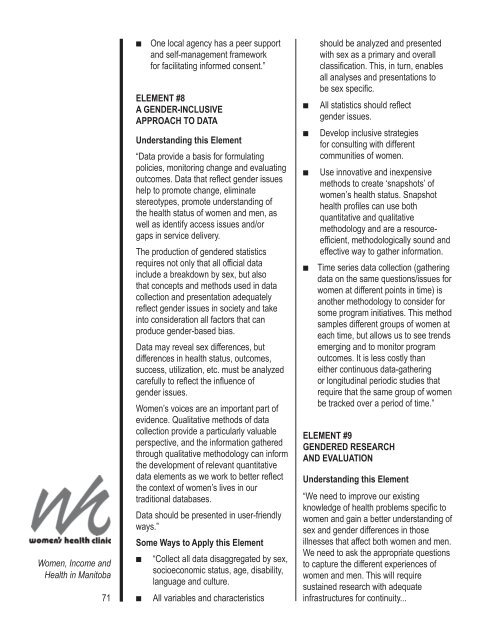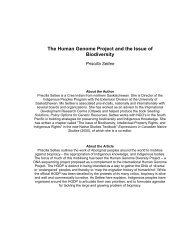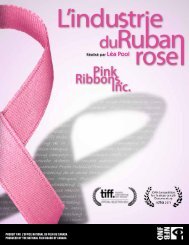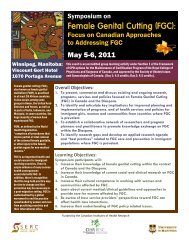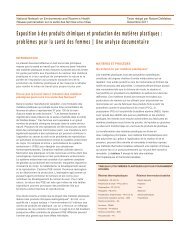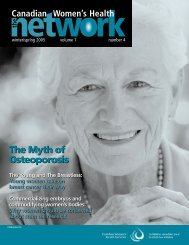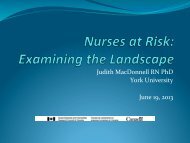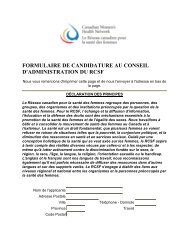here. - Canadian Women's Health Network
here. - Canadian Women's Health Network
here. - Canadian Women's Health Network
- No tags were found...
Create successful ePaper yourself
Turn your PDF publications into a flip-book with our unique Google optimized e-Paper software.
Women, Income and<strong>Health</strong> in Manitoba71■One local agency has a peer supportand self-management frameworkfor facilitating informed consent.”ELEMENT #8A GENDER-INCLUSIVEAPPROACH TO DATAUnderstanding this Element“Data provide a basis for formulatingpolicies, monitoring change and evaluatingoutcomes. Data that reflect gender issueshelp to promote change, eliminatestereotypes, promote understanding ofthe health status of women and men, aswell as identify access issues and/orgaps in service delivery.The production of gendered statisticsrequires not only that all official datainclude a breakdown by sex, but alsothat concepts and methods used in datacollection and presentation adequatelyreflect gender issues in society and takeinto consideration all factors that canproduce gender-based bias.Data may reveal sex differences, butdifferences in health status, outcomes,success, utilization, etc. must be analyzedcarefully to reflect the influence ofgender issues.Women’s voices are an important part ofevidence. Qualitative methods of datacollection provide a particularly valuableperspective, and the information gat<strong>here</strong>dthrough qualitative methodology can informthe development of relevant quantitativedata elements as we work to better reflectthe context of women’s lives in ourtraditional databases.Data should be presented in user-friendlyways.”Some Ways to Apply this Element■ “Collect all data disaggregated by sex,socioeconomic status, age, disability,language and culture.■All variables and characteristics■■■■should be analyzed and presentedwith sex as a primary and overallclassification. This, in turn, enablesall analyses and presentations tobe sex specific.All statistics should reflectgender issues.Develop inclusive strategiesfor consulting with differentcommunities of women.Use innovative and inexpensivemethods to create ‘snapshots’ ofwomen’s health status. Snapshothealth profiles can use bothquantitative and qualitativemethodology and are a resourceefficient,methodologically sound andeffective way to gather information.Time series data collection (gatheringdata on the same questions/issues forwomen at different points in time) isanother methodology to consider forsome program initiatives. This methodsamples different groups of women ateach time, but allows us to see trendsemerging and to monitor programoutcomes. It is less costly thaneither continuous data-gatheringor longitudinal periodic studies thatrequire that the same group of womenbe tracked over a period of time.”ELEMENT #9GENDERED RESEARCHAND EVALUATIONUnderstanding this Element“We need to improve our existingknowledge of health problems specific towomen and gain a better understanding ofsex and gender differences in thoseillnesses that affect both women and men.We need to ask the appropriate questionsto capture the different experiences ofwomen and men. This will requiresustained research with adequateinfrastructures for continuity...


